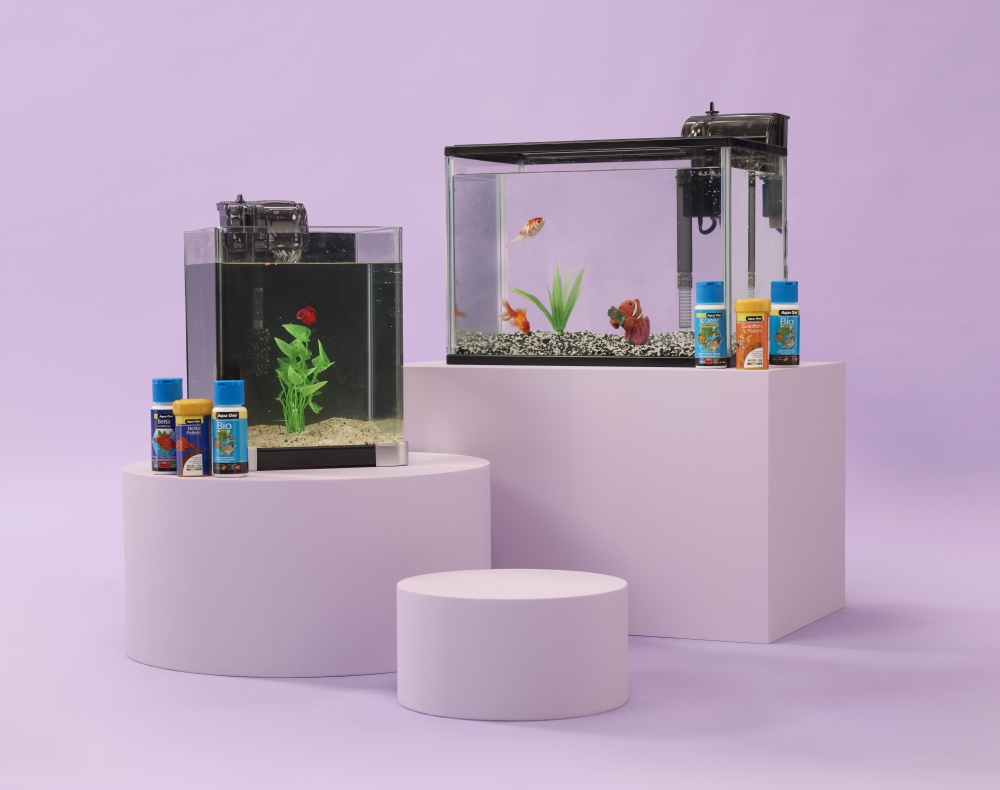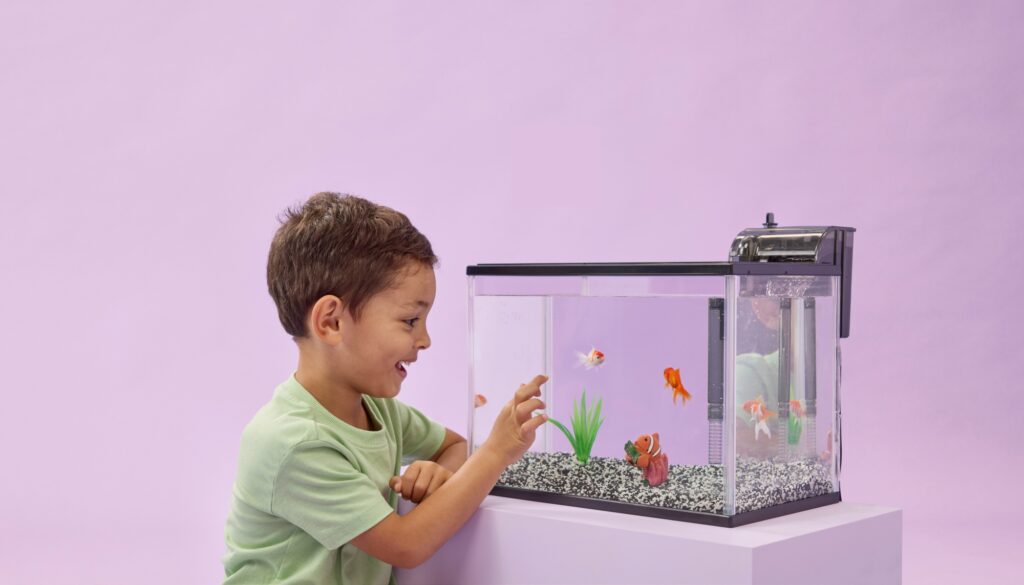So you’ve decided to become a fish parent. Congratulations! A fish tank is more than a home for beautiful swimmers—it’s a world of wonder, a living lesson in care, patience, and routine. Here’s our guide on how to set up a fish tank.
There are a lot of options for setting up your aquarium, with many different sizes and pieces of equipment available. Follow our guide to make sure you know everything you need to provide your fish with a loving home.
Table of contents
Which fish tank is right for you?
In order to enjoy your new aquarium for a long time, you should be sure about the appropriate tank size, furnishing (for example, if it needs its own stand) and position you’re going to have it in.
The size of the aquarium determines the type and number of fish that can live in it and also affects the amount of time that you should plan for the ongoing care of the aquarium.
Remember: many fish you get in store are young. They’ll grow bigger. You need to consider their fully grown size when selecting a tank.
Where to put your fish tank
A quiet, low-traffic area out of direct sunlight is best. Do not put your tank in front of or near a heater or air conditioning unit, as this leads to temperature fluctuations that will stress the fish.
Your tank should be placed near an electricity point so that you can easily plug in your heater and filters. This power point should be on an earth leakage circuit breaker.
Ensure that your tank is sitting on a suitable tank stand or base and floor that will support the weight of the tank.
Fish care checklist
Here is a general list of what you need to set up a freshwater aquarium. Your local Petbarn team members can provide you with the right advice when you are deciding what specifically to buy.
- Fish tank and stand to suit
- Gravel
- Background decoration (optional)
- A filter system that’s appropriate for the tank size and filter media replacements for ongoing maintenance
- Light
- Heater for tropical fish
- Air stone and air pump if needed
- Plants (natural or imitation)
- Tank-safe ornaments such as rocks, driftwood, ornaments, flower pots
- Water conditioner to make tap water safe for fish
- Water additive to help prepare your tank’s biological filtration (e.g. Quick Start, Stability)
- Water test kit to monitor your tank’s water quality
- Fish food appropriate for the fish you plan to get
- Tank cleaning tools such as an algae scraper or sponge and a gravel vacuum
- Fish net
An ideal beginner aquarium is one of the “learner aquarium” or “starter kit” aquariums made by a number of manufacturers. These come with most of the initial things you need to set up a fish tank.

Don’t buy fish immediately
Fish should be the last thing you add to your tank, and not for a week or two after you set it up. You need to allow time for your tank to ‘cycle’ before you can introduce your first fish.
The cycling process is where the filter builds up a population of beneficial bacteria that will break down the toxins like ammonia in the water that are produced by fish waste. Adding products like Quick Start or Stability can help speed this process up, but it cannot be rushed.
After letting your tank cycle for a few weeks, test the water to make sure it is ready for fish. If you’re not sure, bring a water sample into your local Petbarn store for a free water test.
Do I need plants and ornaments in my fish tank?
Plants, roots and other decorations make your aquarium into a beautiful eye-catcher and at the same time fulfil vital functions in your tank habitat. Aquatic plants produce oxygen and provide your aquarium fish with hiding places. Decorative elements, such as tree roots, rocks, or even posters for the aquarium background provide visual variety and always bring a new look to your underwater world.
How to set up a fish tank
While there are some small variations between the set up process for coldwater, tropical, and saltwater tanks, these are the common first steps.
Step 1: Clean out your new tank with tap water
Do not use any sort of chemicals or soaps. Using soaps can leave residue on the glass and harm fish once they go into the tank.
Step 2: Wash your gravel and ornaments in tap water
Wash the gravel thoroughly with tap water in a bucket. Rinse it until all the dust is rinsed off. Repeat the process with your ornaments (rocks, driftwood, etc).
Step 3: Carefully place the gravel and ornaments into the empty tank
For most tanks, gravel in your aquarium should be a depth of one to two centimetres. If you are using an under gravel filter, then place your gravel to a depth of five centimetres.
Once your gravel is in, arrange your ornaments in the tank
Step 4: Install your electrical equipment (but don’t turn it on yet)
Position your filter and heater or air pumps, if you have them, in the tank.
Caution: Do not turn on your equipment until there is water in the tank and your hands are out.
Step 5: Fill your tank with water
An easy way to do this and avoid messing up your ornaments is by placing a plate into the bottom of the tank and pouring water over the top.
Step 6: Add water conditioner
Add water conditioner to the water. Make sure follow the label directions and add the right amount for the volume of water in your tank.
Water conditioner remove toxins in the tap water and adjust pH and water hardness to suit the needs of your fish.
Step 7: Turn on the electrical elements
Once there is water in the tank, you can plug all electrical elements into the power points and turn them on.
Step 8: Add live plants (optional)
If you’re setting up a tropical tank, allow the aquarium time to heat up before adding plants and cycling your tank for fish. This usually takes 12 to 24 hours.
Step 9: Leave your tank to cycle for at least 1-2 weeks
No matter what type of filter you use, ‘good’ nitrifying bacteria need to colonise the tank before it is ready for fish. These bacteria remove toxic waste products such as ammonia from the water in a process called nitrification or biological filtration. New aquariums and filters will not have these bacteria and it can take several weeks to establish a fully functioning biological filter. Water additives like Quick Start and Stability can help speed up this process.
Step 10: Test your water to make sure it’s ready for fish.
Before introducing your fish, test your water conditions using test kits that can read ammonia, nitrate, nitrate and pH levels at minimum. Make sure that your ammonia is 0 and that there are some nitrates present – a sign that you have good bacteria in your tank.
At Petbarn, we offer free water testing. Simply bring in a water sample to your local Petbarn store and we can tell you if your tank is ready for fish or not.
If the water values aren’t right, let your tank cycle for longer and re-test in a few days to weeks. Repeat until the water is ready.
Step 11: Once your tank water is ready, buy your fish
Start slow. When you add fish, ammonia or nitrite can build up to toxic levels if the bacteria in the tank are overwhelmed, causing “new tank syndrome”. The more fish you add, the more ammonia is produced. Therefore it is important that you do not overstock the tank.
Prevent new tank syndrome by:
- Gradually building up the population of fish over four to five weeks.
- Using live plants – these can absorb some of the toxic products directly from the water.
- Only feeding the fish sparingly (once every second day), to reduce the amount of ammonia produced.
- Testing ammonia and nitrite levels – partially change water as needed.
- Being mindful of your pH levels. Lowering pH reduces the toxicity of ammonia.
- Using products like Quick Start, Stress Zyme or Stability to boost nitrifying bacteria levels.
At Petbarn, we have a 30 day fish guarantee. If you’ve set up your tank well, fully cycled it, and tested your water to make sure your tank was ready to add fish, but your fish dies within 30 days of adding it to a tank, we’ll replace it. T&Cs apply.
Step 12: Add the fish to your tank
Let your fish float in their bags on top of the water for 15-30 minutes – this allows your fish to adjust to the temperature of the tank. Once they’re ready, use a net to scoop your fish out of the bag and gently place them into the tank.

Frequently asked questions about fish
Do fish make good pets?
Fish make great pets for kids and adults. They’re quiet and calming to watch but colourful and exciting to look at. While they still need care and tanks need to be maintained, they may be easier to keep than more traditional pets. And, depending on the type of fish and tank, they don’t need as much space.
Can fish live in tap water?
Water straight out of your tap is not safe or fish. It needs to be treated with water conditioner before it is safe for fish to live in.
Can fish live in a bowl?
No, it’s not advised to keep fish in small bowls. They need to be in an appropriately sized tank with a filter.
What do I feed my fish?
Like humans, quality nutrition plays a huge part in keeping your fish alive and well. It is important to also select the right variety of food for your fish.
One thing to consider is the area of the tank in which your fish dwell. For example, top-dwelling fish such as Hatchetfish and Halfbeaks are best suited to flakes, as these will float on the surface. For medium-dwelling fish, such as Goldfish and Gourami, crisps (which sink slowly) are a good option. Finally for bottom-dwellers like Cories, Loaches and Catfish, a wafer is ideal as it will quickly sink to the bottom for them to devour.

